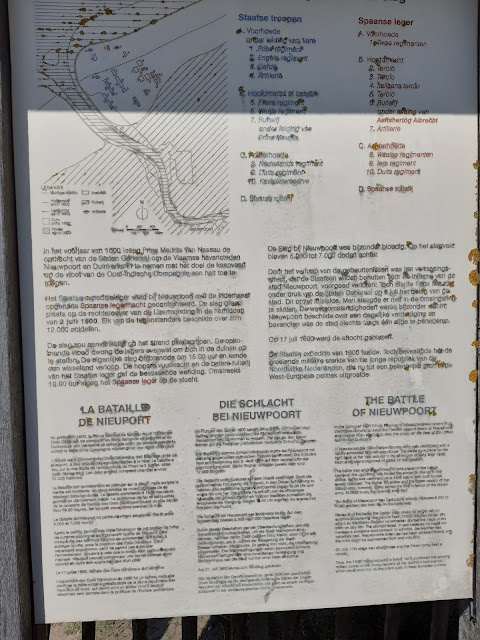The dunes are very dificult terrain to march through, the dry sand, steep slopes of the dunes. Imagine doing that with armour, pikes or heavy equipment. Keeping formation almost impossible Impossible to keep an overview of the battle. Attacking in these circumstances is madness. But the Archduke Albrecht gave the order. With the incomming tide, the States ships were comming closer to the shore. Albrecht fiered the States army would escape.
The States army, led by Prins Maurtis was on a mission to besiege the privateers town of Nieuwpoort and Duinkerken ordered by the States General of the 7 Provinces. The Archduke Albrecht hastely assembled an army , of which a big part did a forced march covering 120km in 4 days. With a big part of his army exhausted, yet another reason the Archduke should not have attacked in such a difficult terrain.
Prins Maurits an his States army were completly surprised by how quick the Spanish army had been assembled. His army was trapped, adn he could only hope to escape with a small part of the army in case the Spansh force would keep position. His only hope in that case would have been to attack himselve...
Maurits was victorious, but the campaign was a fiasco. On the other hand, losing the one major army of the States would have been a disaster. That is why this battle is so important for what would become the Dutch nation.
Another thing Maurtis had learned during his campaign was that the inhabitants of the Southern (Spanish occupied) Netherlands were alienated of the idea of the united 17 provincies . For a major part, this found its orrigin in the raiding parties undertaken by the last protestant stronghold in the Southern Netherland : Oostende.
The unjustly forgotten siege of Ostend (1601-1604) and the fall of this stonghold sealed the rupture of the once United Provinces of the Low Countries.
Appart from these plates and a small statue closer to town nothing remindes of the battle.











I've never quite understood what the Spanish were doing in the Netherlands in the first place. They are a long way from Spain, with France in between. Can you educate a dumb American?
ReplyDeleteHi Nick,
ReplyDeleteA small question, that can’t be answered in one sentence. I’ll try to keep it brief.
In the Middle Ages, the county of Flanders (the current provinces in Belgium of East- and West Flanders and a part of Northern France) and duchy of Brabant (current provinces of Flemish- and Walloon-Brabant, Antwerp and the Dutch province of Nord Brabant) were rich regions, densely populated. Gent was the biggest town in Western Europe after Paris, 3 of the 5 biggest cities of Werstern Europe being in the county of Flanders.
In France, you had the dynasty of the dukes of Burgundy, the first being Philip the Bold, brother of the French king. Starting with him, the dukes enlarged their territory through marriage, war, diplomacy and extortion. Under duke Philip The Good, the Low Countries were politically more or less united with a states general, some kind of parliament with representatives of all the provinces. After the death of duke Charles the Bold, his daughter Mary married Maximilian of Habsburg, the Emperor of the Holy Roman Empire. Their son, Philips the Handsome married Joanna of Castile, heir of Spain(!!). Their son Charles V (born and raised in Flanders) became the Emperor and king of Spain, Duke of Burgundy and Lord of the Netherlands (https://en.wikipedia.org/wiki/Low_Countries) ). Charles V was confronted with the rise of protestant reformation in Germany. His son, Philip II became king of Spain and Lord of the Netherlands, Charles V’s brother Ferdinand was elected Emperor of the Holy Roman Empire.
Philip II was born in Spain, didn’t connect with the free spirit of the Low countries, and violently opposed the rise of protestant religion. The Low Countries declared independent ( “Plakkaat van Verlatinghe” which inspired the American Declaration of Independence, you should also read this : http://flemishamerican.blogspot.be/2013/07/the-flemish-contribution-to-us.html) .
This declaration was the start of the 80 Years war, with Spain sending troops, quickly occupying the Southern part (more or less nowadays Belgium and Luxembourg) , but failing the occupy the North; A large part of the population (and wealthiest ) of the southern Netherlands (Flanders and Brabant) fled to the North, contributing to the Golden Age of what became later the Dutch Republic.
The (remaining and unoccupied) United Provinces led by the States General succeeded in keeping at bey the Spanish armies. The protestant rebels were supported by Elisabeth I of England. That, (and also because Philips II had been married to the English queen Mary Tudor (Bloody Mary) ) was the cause for forming the great Armada.
In 1648, the war between Spain and the Dutch Republic ended.
Spain now was confronted by the ambition of king of France Louis XIV . Again the Spanish Netherlands were the battlefield, and not much remained of the wealth of Flanders of the middle ages
After the War of the Spanish Succession (1701-13) The Southern, or Spanish Netherlands, became the Austrian Netherlands until the French revolutionary wars, and became a battlefield again until Waterloo.
From 1815 till 1830 the Netherlands were reunited, but the differences had become to big, and after the Belgian revolution the Netherlands were again divided.
Hope this helps a bit
Thank you, Dirk. I understand the conflicts better now.
ReplyDelete